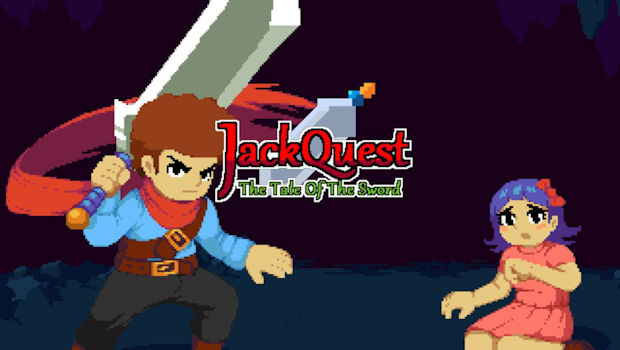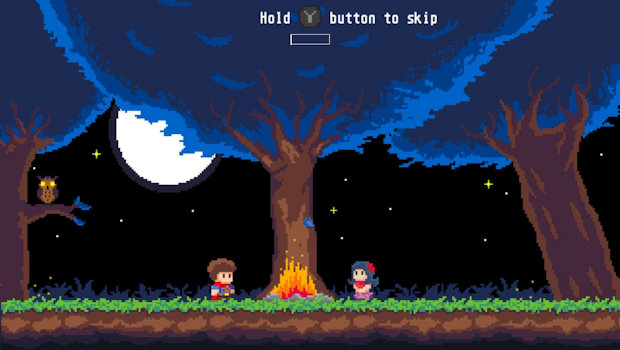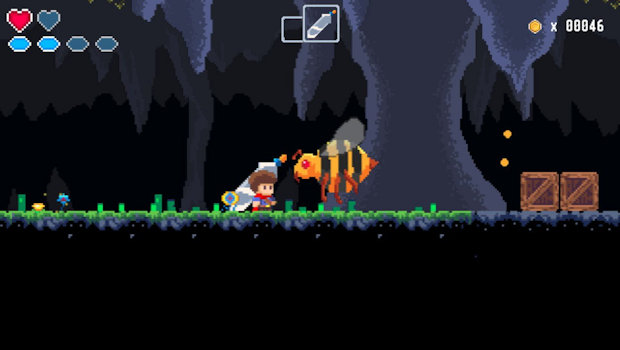There are a ton of indie retro-style platformers. Every week it seems like a new one is releasing and sometimes they blur together. JackQuest: The Tale of the Sword is the latest of these but you’d be forgiven if you think you’ve already played it as it does little to distinguish itself from the rest of the pack.
The game starts off simply enough with Jack and his love Nara enjoying a quiet night in the forest. Nara starts to sing Jack a love song and the evil Korg burrows out of the ground and kidnaps the damsel setting Jack on his quest to save her.
JackQuest eases you into the action with a few tutorial sections that introduce the player to the general mechanics. At first it is simple platforming, then simple combat, and then more complex platforming with a wall bounce and double jump. It’s all pretty standard fare that seems fine. But that is where JackQuest stays, seemingly fine.
The overall game is designed similar to Metroid but instead of the differing biomes of Metroid, all of JackQuest takes place inside a fairly bland cave. Like Metroid you’ll need to acquire special abilities to progress in some areas and these can be tucked away in some nook and cranny type spaces. Unlike Metroid though, the cave in JackQuest is a labyrinth of twisting pathways that all look exactly the same and make it hard to determine exactly where in the cave you are. Worse, the game does have a map but you won’t receive it until about the halfway point of the game and its usefulness limited by it only being viewable through a weird fishbowl lense that you have to scroll with to try and navigate.
The platforming is pretty standard fare with a few challenging bits here and there but nothing especially memorable and the same can be said about most of the combat. Jack and his giant talking sword can hack and slash at enemies in his way and none of the standard critters cause much issue, aside from a few instances of spiders being placed in the middle of platforming sections causing you to sometimes jump directly at an offscreen projectile. More challenging are the handful of boss battles will partake in over the course of the game.
It isn’t necessarily that the boss battles are difficult, in fact they all follow rather simple patterned attacks, but rather that they are generally damage sponges that require can take a bit to get through and they are often positioned after a gauntlet of enemies and platforming that are positioned after a checkpoint. I had a bit of trouble with a mid-game boss because it required some perfect platforming over spike pits while dealing with spiders shooting web projectiles and I rarely went into the fight perfectly ready.
I’m not going to lie, I was very close to quitting the game at that mid-game boss but after finally finishing it off, the rest of the game was a breeze as I stumbled across some heath and power meter improvements. In fact, the final boss was a ridiculous walkover that I beat on my first try. Unfortunately the game froze at that point and I had to do the run again, which was done immediately.
Aside from the one game freeze though, JackQuest runs pretty smoothly, albeit with some excessive load times. Maybe I was spoiled last year by Celeste immediately popping me back in the game to try again but the load times in JackQuest felt a bit long. However when in game, it is responsive and feels like you’d expect.
Feeling like you’d expect is kind of the story of JackQuest, there is nothing that had me in awe on either end. It’s fine and for a game produced mostly by one person that is priced well enough, that was all I really needed. It does however enter a market filled with these types of games and it doesn’t do anything to stand out so I’d forgive you if you thought you already played it.
This article was written with material provided from the developer for the Nintendo Switch. For more on our review process, please read here.


